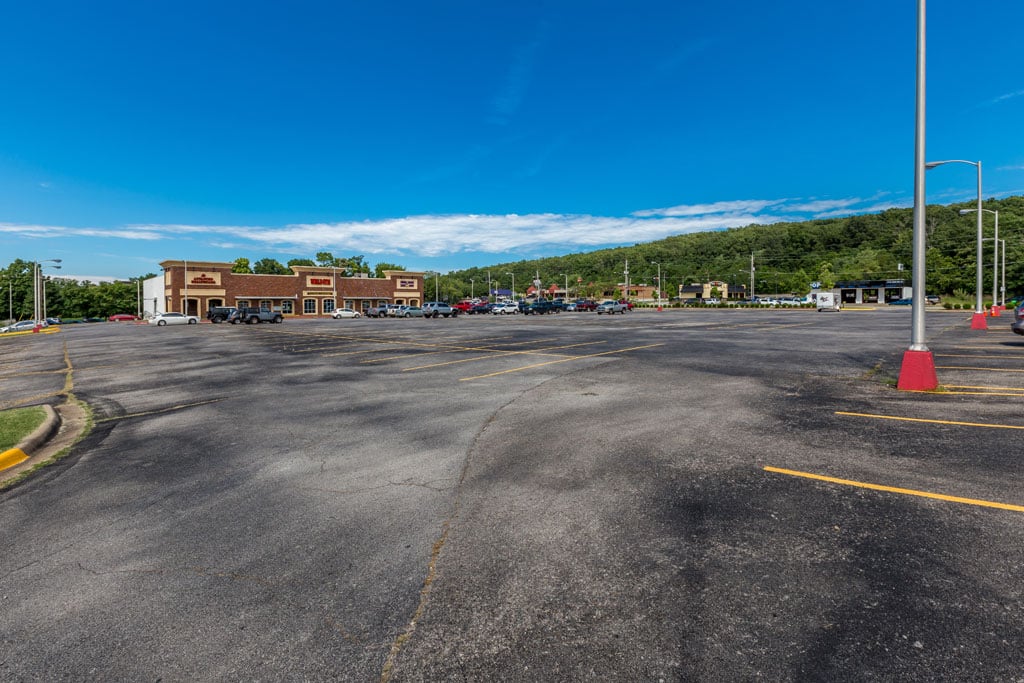
The parking lot at 2035 N. College Ave. sits nearly three-fourths empty on Aug. 10.
Photo: Todd Gill, Fayetteville Flyer
Fayetteville aldermen will soon discuss whether the city should stop requiring businesses to provide a set number of parking spaces for their customers.
If approved, Fayetteville would become the first city in Northwest Arkansas to completely eliminate minimum parking standards for businesses.
The proposal was brought forward by city planners last month as a way to encourage infill in downtown Fayetteville and other areas where minimum parking requirements are difficult to meet. The plan was later approved by the Planning Commission, but it’s now up to the City Council to make the final decision.
For decades cities have relied on minimum parking standards to make sure people have a place to park and to protect businesses from having their parking spaces filled with another shop’s customers.
However, some say requiring a minimum number of on-site parking spaces can do more harm than good.
Fayetteville minimum parking standards
Single-family home: 2 per dwelling unit
Bank: 1 per 200 square feet
Barber or beauty shop: 2 per chair
Elderly housing: 1 per 2 units
Golf course: 3 per hole
Hospital: 1 per bed
Professional office: 1 per 300 square feet
Restaurants: 1 per 100 square feet
Retail: 1 per 250 square feet
In Fayetteville, the rules are based mostly on square footage. A restaurant must include one space for every 100 square feet, and retail shop owners are required to provide one space for every 250 square feet.
That means a 4,000-square-foot drive-thru restaurant must have a minimum of 40 parking spaces, and a 200,000-square-foot retail center must provide at least 800 parking spaces.
Planning Commissioners criticized the rules for not considering the location of the business and for seemingly being set to satisfy peak demand instead of normal, everyday traffic.
“I think we should have learned by now that designing parking lots for the day after Thanksgiving…is probably a bad idea,” said Commissioner Tracy Hoskins, a longtime local businessman and developer.
Commissioners said forcing businesses to include a set amount of parking spaces not only leads to the construction of massive parking lots that discourage pedestrian and bicycle transport, but also limits both development and redevelopment of properties around town.
By eliminating minimum parking standards, commissioners said Fayetteville could position itself as a more business-friendly city.
“This is absolutely one of the best progressive things that I’ve seen the staff embark on since I’ve sat on this commission,” said Hoskins. “I’ve always thought it was crazy to have minimum parking standards. Let the people that own, operate, and invest in those businesses determine what they need.”
Commissioner Matt Hoffman agreed and said incentivizing infill will lead to a more livable environment for Fayetteville residents.
“I think this is an excellent opportunity to remove a layer of regulation and also in the process really encourage the kind of shining city we’d all like,” said Hoffman.
Hoffman said residents might be surprised to know how just much land is dedicated to serving parked vehicles around town.
“Contrary to what some people might think, the most prevalent land use in the city of Fayetteville is not small businesses or large businesses or parks or schools,” Hoffman added. “It’s actually parking lots.”
He said there are 1,000-linear-foot stretches of College Avenue that only include 10 businesses. That same stretch of road, he said, in other cities that don’t require so much parking might include up to 100 businesses.
Commissioners admitted the new philosophy could cause some issues at first, such as spillover parking in both commercial and residential areas, but said people will eventually adjust.
“People actually will self-select,” said Hoffman. “If you make it harder for them to drive, then they’ll walk. If you make it easier for them to drive, they’ll drive.”
Hoskins agreed.
“I think that this will present a few problems over time,” said Hoskins. But the question is does this cure more problems than it creates? And absolutely, it does.”
The City Council is set to consider the proposal on Sept. 1.
Fayetteville minimum parking standards
Fayetteville requires a certain number of parking spaces be included in new developments and redevelopments based on the building’s use. Those space requirements can be reduced by submitting an official shared-parking agreement with a neighboring property owner, or by adding bicycle racks or motorcycle spaces. Reductions are also allowed for properties located within a quarter-mile of a bus stop. The requirements don’t apply to buildings in downtown Fayetteville zoning districts that were built before Oct. 1, 1995.
Residential
Single-family, duplex, triplex: 2 per dwelling unit
Multi-family or townhouse: 1 per bedroom
Commercial
Agricultural supply: 1 per 500 square feet
Amusement: 1 per 200 square feet
Auditorium: 1 per 4 seats
Auto/motorcycle service stations: 4 per each enclosed service bay
Bank: 1 per 200 square feet
Barber or beauty shop: 2 per chair
Building/home improvement: 1 per 500 square feet
Coin-operated laundry: 1 per 3 machines
Dry cleaning: 1 per 300 square feet of retail area and 1 per employee
Hotels and motels: 1 per guest room, plus 75% of spaces required for accessory uses
Furniture and carpet store: 1 per 500 square feet
Plant nursery: 1 per 1,000 square feet of indoor/outdoor retail area
Restaurants: 1 per 100 square feet plus 4 stacking spaces per drive-thru window
Retail: 1 per 250 square feet
Retail fuel sales with convenience stores: 1 per 250 square feet of retail floor area. Owner may count spaces at pump islands as parking spaces.
Retail fuel sales only: 1 per employee. Owner may count spaces at pump islands as parking spaces.
Office
Medical/Dental office: 1 per 250 square feet
Professional office: 1 per 300 square feet
Sales office: 1 per 200 square feet
Public and Institutional Uses Nonprofit Commercial
Art gallery, library, museum: 1 per 4 seats, provided only auditorium space is counted in determining parking
Auditorium: 1 per 4 seats, provided only auditorium space is counted in determining parking
Child care center, nursery school: 1 per employee plus on-site loading and unloading spaces at a rate of 1 per 10 children accommodated
Church/religious institution: 1 per 4 seats in the main auditorium or 1 per 40 square feet of assembly area, whichever provides more spaces
College auditorium: 1 per 4 seats
College dormitory: 1 per sleeping room
College or university: 1 per 500 square feet of classroom area
Community center: 1 per 250 square feet
Cooperative housing: 1 per 2 occupants
Convalescent home, assisted living, nursing home: 1 per 2 beds
Detention home: 1 per 1,500 square feet
Elderly housing: 1 per 2 units
Funeral homes: 1 per 4 seats in main chapel plus 1 per 2 employees plus 1 reserved for each vehicle used in connection with the business
Government facilities: 1 per 500 square feet
Hospital: 1 per bed
Convalescent home: 1 per bed
School-elementary and junior high: 1 per employee plus 1 space per classroom
School-senior high: 1 per employee plus 1 per 3 students based on design capacity, or 1 per 6 seats in auditorium or other places of assembly, whichever is greater
Zoo: 1 per 2,000 square feet of land area
All other public and institutional uses (only auditorium space shall be counted for churches, auditoriums, or group occupancy space): 1 per 4 occupants
Manufacturing/Industrial
Manufacturing: 1 per 1,200 square feet or one per employee, whichever is greater
Heavy industrial: 1 per 1,200 square feet
Extractive uses: Adequate for all employees, trucks, and equipment
Recreation
Amusement park, miniature golf: 1 per 1,000 square feet of site area
Bowling alley: 6 per lane
Commercial recreation: 1 per 200 square feet
Commercial recreation-large sites: 1 per 1,000 square feet of site area
Dance hall, bar or tavern: 1 per 50 square feet, excluding kitchen
Golf course: 3 per hole
Golf driving range: 1 per tee box
Health club, gym: 1 per 150 square feet
Regional or community park: 2 per acre of accessible active and passive space
Neighborhood park: None
Private club or lodge: 1 per 500 square feet or 1 per 3 occupants based on the current adopted Standard Building Code whichever is greater
Riding stable: 1 per acre; not required to be paved
Tennis court: 2 per court
Theater: 1 per 4 seats
All other recreational uses: 1 per occupants
Warehousing and Wholesale
Warehousing: 1 per 2,000 square feet
Wholesale: 1 per 1,000 square feet
Center for collecting recycled materials: 1 per 1,000 square feet
Source: City of Fayetteville

